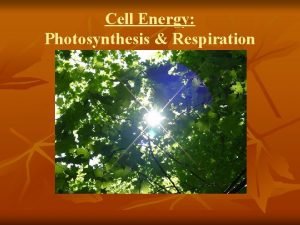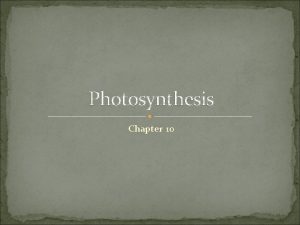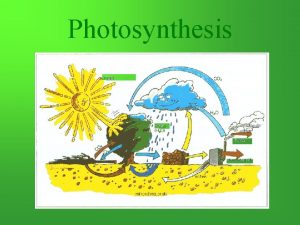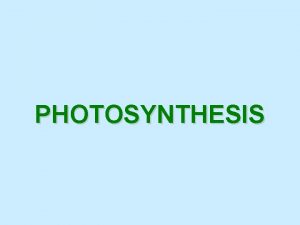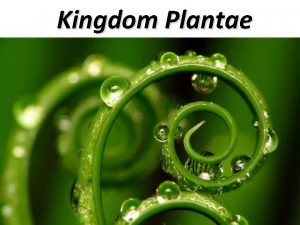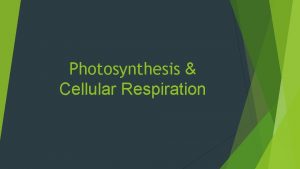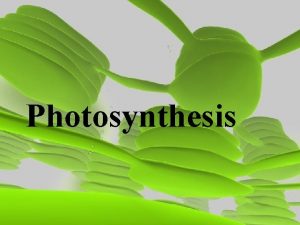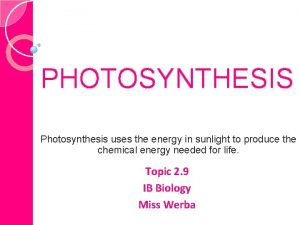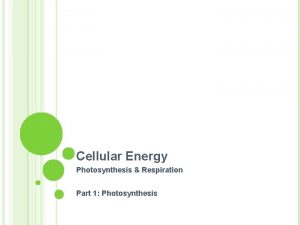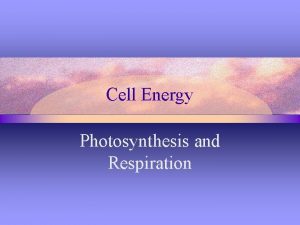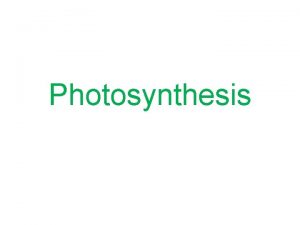Photosynthesis Chapter 10 Photosynthesis Photosynthesis uses the energy



















- Slides: 19

Photosynthesis Chapter 10

Photosynthesis �Photosynthesis uses the energy of sunlight to convert water and carbon dioxide into high-energy sugars and oxygen

Photosynthesis 6 CO 2 + 6 H 2 O + (light) C 6 H 12 O 6 + 6 O 2 Use of inorganic compounds to make organic sugar and oxygen Tells you what you need, but doesn’t tell you what happens

Photosynthesis Light and Pigment The equation tells you what is needed, BUT not what happens Photosynthesis requires light and a substance called chlorophyll Found in chloroplasts Makes plants look green

The Reactions of Photosynthesis Inside a Chloroplast The organelle where photosynthesis takes place Thylakoid Saclike photosynthetic membranes Grana (Granum) Stacks of thylakoids Photosystems Clusters of pigment and protein that absorb light energy Stroma Area outside of the thylakoid in the chloroplast

Photosynthesis Stomata Specialized openings for the entrance/exit of gases Formed by guard cells Respond to water pressure Open – high water pressure or turgor pressure Closed – low water pressure

Photosynthesis Consists of two stages Light reactions Convert light energy to chemical energy Dark reactions No light required

Photosynthesis Light reaction responsibilities: Water is split Light energy absorbed is transferred to an electron carrier NADP+ NADPH Oxygen is given off as a byproduct ATP is generated by chemiosmosis NO SUGAR PRODUCTION!

Photosynthesis Dark reaction responsibilities: Calvin Cycle Uses CO 2 from the air to make organic molecules Uses NADPH to produce sugars Uses ATP in the production of sugars

Sunlight Fundamentals Light is a form of energy Travels in wavelengths Most concerned with the visible light spectrum The amount of energy in a wavelength is inversely proportional to the wavelength Shorter wavelength = more energy

Light Absorption Light is absorbed by pigments Pigments in plants are called chlorophylls and carotenoids Chlorphyll a – violet/blue and red light Chlorophyll b – slightly different wavelengths from a Carotenoids – blue and green (appear yellow and orange)

Capturing Light Energy Sunlight causes electrons to move from the ground state to the excited state Energy can not disappear Excited state is very unstable

Photosystems Made up of chlorophyll and inorganic molecules Reactive center surrounded by light harvesting units Reactive center has a pair of chlorophyll a molecules Light harvesting molecules has chlorophyll a, b, and carotenoids

Photosystems 1. 2. 3. 4. 5. 6. 7. 8. Light hits a pigment in Photosystem II-electron excited Energy is transferred to the chlorophyll a electrons and then to the primary electron acceptor Water splits to give 2 electrons, 2 H+, and 1 O atom Excited electrons pass from primary electron acceptor of PS II to PS I via electron transport chain (ETC) Energy is released from electrons falling back to ground stateused to make ATP Light energy also being absorbed by PS I just like PS II Excited electrons from PS I now travel through a second ETC Electrons are now transferred to NADP+ (reduction) to make NADPH

Cyclic Electron Flow Certain bacteria do not use PS II Electrons cycle back to the cytochrome complex of first ETC Does not produce NADPH production or O 2 release, but there is ATP production Ex. Purple sulfur bacteria

Comparing Chemiosmosis in Mitochondria and Chloroplasts Mitochondria Chloroplasts Generates ATP Uses H+ gradient for potential energy High energy electrons come from breakdown of organic molecules Chemiosmosis is used to tranfer chemical energy from food ATP potential energy Electrons come from water and become energized by light Transform light energy into chemical energy in ATP

Calvin Cycle Anabolic cycle Builds sugars from smaller molecules Consumes energy 3 Steps Carbon fixation Reduction Regeneration of Ru. BP Two cycles will result in 12 G 3 P which will exit independently and become glucose

Photorespiration Plants may need to modify photosynthesis in times of low CO 2 Instead of CO 2 using the plant will use O 2 in the Calvin cyle The result is a 2 carbon molecule Leaves the chloroplast and peroxisomes/mitochondria rearrange the split Photorespiration

Importance of Photosynthesis Plants consume about 50% of the sugars they make to perform daily activities Produces about 160 billion metric tons of carbohydrates per year There is no chemical process on earth that can match the output of photosynthesis
 Photosynthesis transforms light energy into chemical energy
Photosynthesis transforms light energy into chemical energy How do plants get glucose
How do plants get glucose Energy energy transfer and general energy analysis
Energy energy transfer and general energy analysis Energy energy transfer and general energy analysis
Energy energy transfer and general energy analysis Chapter 7 energy conservation of energy
Chapter 7 energy conservation of energy Hình ảnh bộ gõ cơ thể búng tay
Hình ảnh bộ gõ cơ thể búng tay Bổ thể
Bổ thể Tỉ lệ cơ thể trẻ em
Tỉ lệ cơ thể trẻ em Chó sói
Chó sói Chụp tư thế worms-breton
Chụp tư thế worms-breton Hát lên người ơi
Hát lên người ơi Môn thể thao bắt đầu bằng chữ đua
Môn thể thao bắt đầu bằng chữ đua Thế nào là hệ số cao nhất
Thế nào là hệ số cao nhất Các châu lục và đại dương trên thế giới
Các châu lục và đại dương trên thế giới Cong thức tính động năng
Cong thức tính động năng Trời xanh đây là của chúng ta thể thơ
Trời xanh đây là của chúng ta thể thơ Cách giải mật thư tọa độ
Cách giải mật thư tọa độ Phép trừ bù
Phép trừ bù độ dài liên kết
độ dài liên kết

